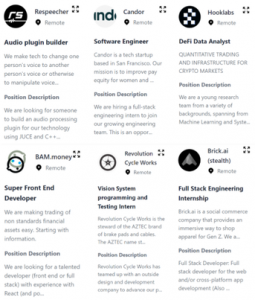Finding an Internship (May – October)
“The IMSA Internship program connects high school juniors and seniors to real-world learning experiences with business professionals, nonprofits, and entrepreneurial mentors to carry out an industry, business, or product-focused research project” (IMSA Internship Program). The program has provided three helpful resources on finding internships: their webpage, the Internship Program brochure, and the 6 Steps to IMSA Internship infographic.
Building a Resume
The Acronym sat down with the Manager of the IMSA Internship Program, Sue Fricano, to get insider tips on this intimidating process. Fricano started broad: how can IMSA students get any internship they really want? Start by making a LinkedIn page and building your resume on there. Create a “skills-focused” resume highlighting your power skills (communication, critical thinking, etc.) and technical skills (database management, web design, etc.). For 1-page resumes, check out these amazing templates. When you’re done, get it reviewed for free by the IN2 team.
Some students go above and beyond and create their own Wix sites. This allows them to include more information about their personality, interests, and past projects that LinkedIn may not necessarily accommodate. In addition, Wix gives students the liberty to be creative and original with their resumes. Having a website with eye-catching graphic design can in-and-of-itself be a selling point.
Networking on Linkedin
Next, find businesses you like and research positions available within that company. Now you can start creating a network. Message employees of that business. Ask them, “I’m really interested in your area of work. I’d like to hear your story and how you got started. Could we set up a Zoom call sometime soon?” Establish trust with someone local, and you might be able to physically intern at the actual business. It sounds much more daunting than it is. Bottom line is, everyone has been in your shoes at one point. Almost everyone wants to help students like you. Fricano gave an anecdote of how her daughter landed 6 job offers before graduating college. Six came from messaging on LinkedIn, zero from college fairs and other similar venues. Unfortunately, students are often too intimidated to reach out to people. It’s important to realize that in the worst-case scenario, someone says no or ghosts you. With the former, you can still follow up. Ask them, “Do you have any suggestions of people I can talk to if you’re not available?”.
Finding an Internship
Being an IMSA student equips you with an amazing personal network. Go to Digital Commons and view past student Internship Final Reports. This will give you an idea of what students have done historically. Message the student(s) on projects that interest you. Ask questions about their experience such as mentor support, inclusion in meetings, engagement, and quality of projects. Pay close attention, as this could very well be your internship. After all, if businesses have already mentored IMSA students, they are far more likely to take more.
The IMSA Internship Program is very proactive in finding opportunities for its students. Every year they will publish a list of Available Internships. These businesses, often run by alumni and parents of alumni, understand the advanced skill set of IMSA students and plan to nurture it. In fact, it’s important to make sure that your internship will challenge you properly. Don’t be the stereotypical grabbing-coffee, making-copies, and filing-paperwork intern. Startups are a good place to look. They often need lots of research and give students real projects that are impactful and relevant to their mission.
While remote internships have versatility and flexibility, in-person internships provide hands-on experience and better connections with mentors. IN2 has partnered with many local innovation hubs like 1871, Innovation Dupage, Techstars Chicago Accelerator, MATTER Chicago, Community Collective, and Bureau Gravity just to name a few.
Public Resources
There is also a myriad of public resources available for finding internships. You have the standard sites like Indeed (#1 job search site — can narrow down to local internships around IMSA), USA Jobs (in conjunction with the federal government’s Internship Program), and Chegg Internships (all-encompassing resource guide). A deeper dive gives SLINGSHOT (a platform that connects STEM students with startups), Global Talent Mentoring Networking (connects high-achieving STEM students with outstanding mentors), and College Vine’s 24 Awesome Internships for High School Students.

A condensed version of SLINGSHOT’s internship listing page
Finally, remember “business” is a general term used for all agencies/industries that offer a learning and working environment for interns. In reality, “IMSA Interns have worked in a variety of industries such as Emerging Technologies, Education, Health Science, Marketing and Media, and Politics and Economics” (6 Steps to an IMSA Internship). At the end of the year, interns are expected to submit a Final Business Project Report detailing their work, what they learned, what was successful, and what could be improved.
Internships can be intimidating, but it’s an invaluable experience. As a high school student doing 8 hours of business projects every week, you will certainly stand out amongst your peers.
If you have any questions about the Internship Program, please contact Sue Fricano at sfricano@imsa.edu.
Best of luck!
The Acronym






Be the first to comment on "Advice to Juniors: Finding an Internship"